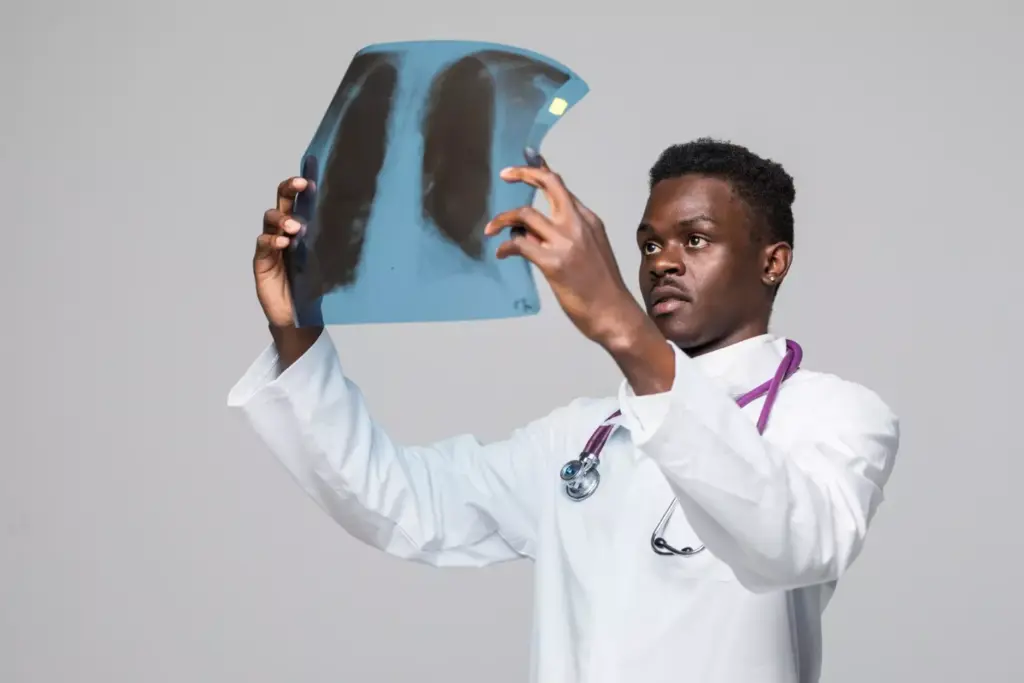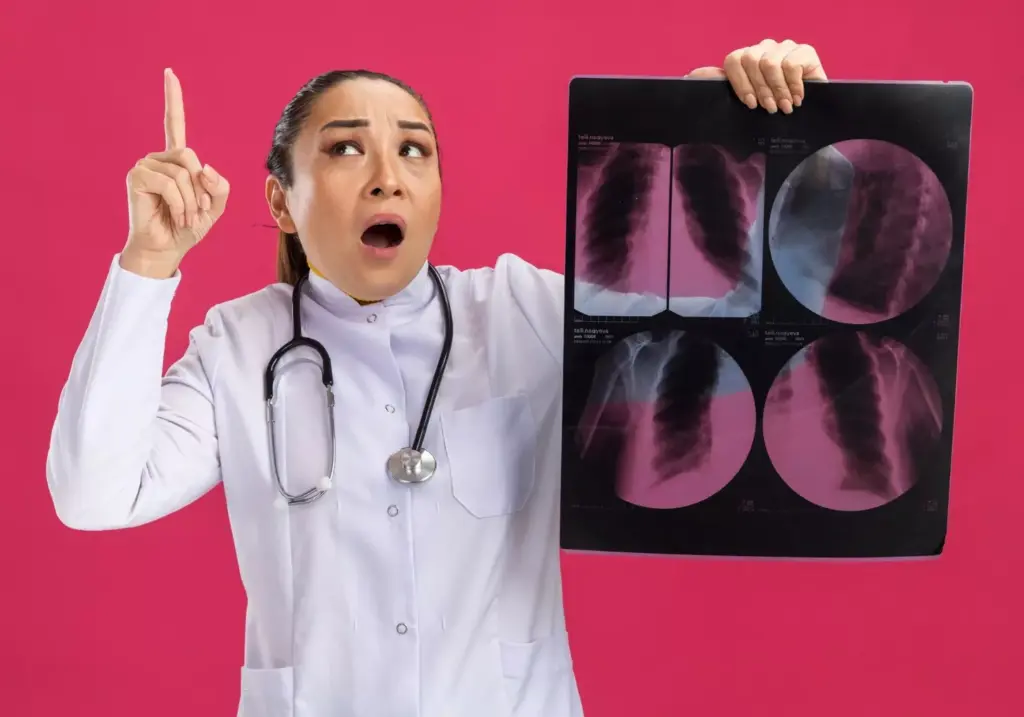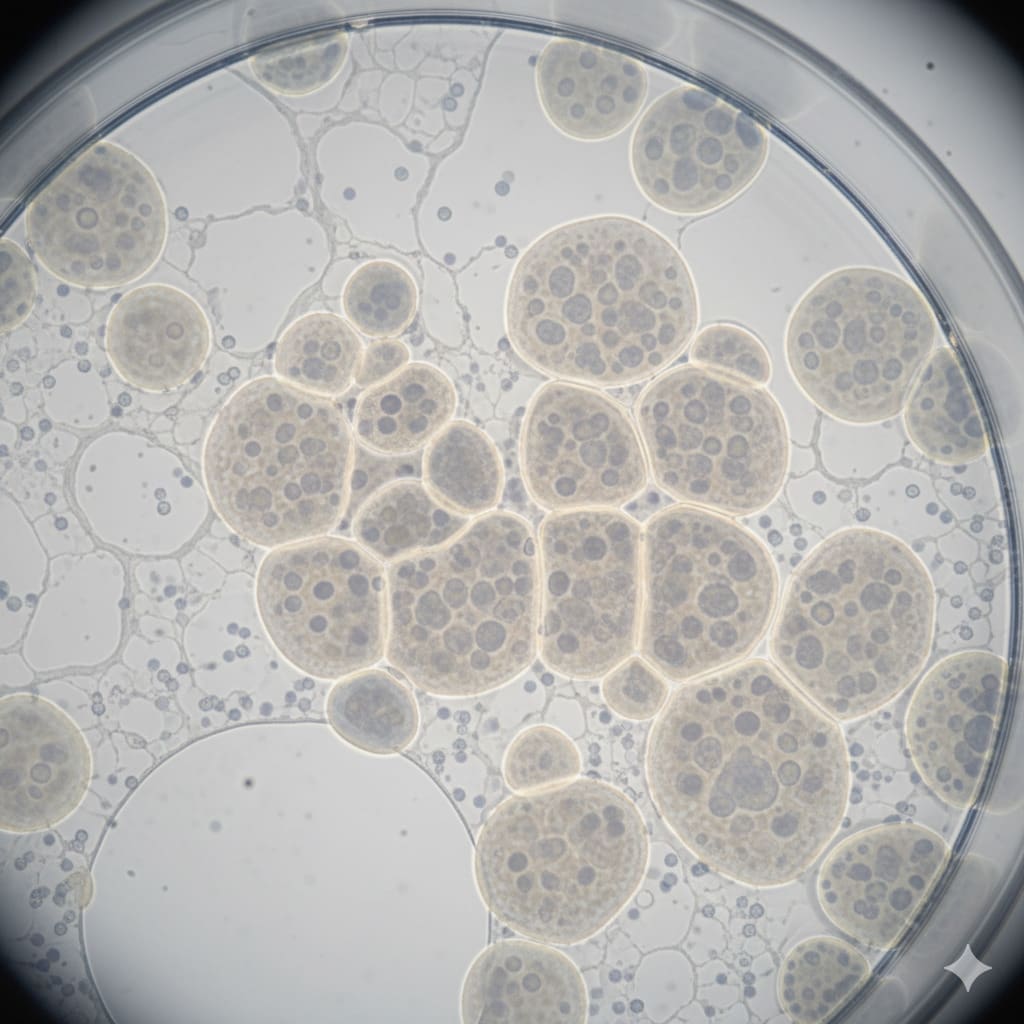Last Updated on November 26, 2025 by Bilal Hasdemir

Non-small cell lung cancer is a big health issue, making up about 85% of lung cancer cases. At Liv Hospital, we keep up with the newest ways to treat this disease.
New discoveries in targeted therapies and immunotherapies have made treatments better for NSCLC patients. We have many treatment choices, like surgery, radiation, and regular chemotherapy.
Our team works hard to give top-notch care to patients from all over. If you’re looking into treatments, knowing about the chance of a cure in lung cancer treatment might help.
Key Takeaways
- NSCLC makes up about 85% of all lung cancer cases.
- New advances in treatments have made things better for patients.
- Liv Hospital offers many treatment options for NSCLC.
- Our team is dedicated to giving the best care to international patients.
- It’s important to know about the latest treatment options for NSCLC.
Understanding Non-Small Cell Lung Cancer and Its Subtypes
NSCLC includes squamous and non-squamous cell lung cancer. Each has its own traits and treatment plans. Knowing these differences is key to finding the right treatment.
Squamous vs. Non-Squamous NSCLC
NSCLC is split into squamous and non-squamous types. Squamous cell carcinoma comes from squamous cells in the airways. Non-squamous NSCLC includes adenocarcinoma and large cell carcinoma.
Choosing between squamous and non-squamous NSCLC matters for treatment. Some treatments work better for non-squamous NSCLC, like those with certain genetic changes.
The Role of Molecular Profiling in Treatment Selection
Molecular profiling has changed how we treat NSCLC. It finds specific genetic changes that certain drugs can target. Epidermal Growth Factor Receptor (EGFR), Anaplastic Lymphoma Kinase (ALK), and KRAS mutations are key.
- EGFR mutations are common in non-squamous NSCLC and respond well to EGFR inhibitors.
- ALK rearrangements are found more in non-squamous NSCLC and are treated with ALK inhibitors.
- KRAS mutations are important targets, but they often mean a drug won’t work as well.
By knowing a patient’s NSCLC’s molecular makeup, we can pick the best treatment. This improves their life and health.
Surgical Interventions for Non Cell Lung Cancer
Surgery is key in treating non-small cell lung cancer. It offers different methods based on the patient’s needs. The choice of surgery depends on the tumor’s stage, location, and the patient’s health.
Lobectomy: Removing a Lung Lobe
A lobectomy removes the lung lobe with the tumor. It’s often the first choice for early-stage NSCLC. Removing the lobe can cure the disease or greatly improve survival chances. We check if the patient can handle losing a lobe.
Pneumonectomy: Complete Lung Removal
For bigger tumors or those in the chest’s center, a pneumonectomy might be needed. This means removing the whole lung. Thanks to better surgery and care, more patients are doing well after this surgery. We talk about the risks and benefits with our patients.
Minimally Invasive Surgical Techniques
Techniques like VATS and robotic surgery are less invasive than open surgery. They use smaller cuts, cause less damage, and lead to faster recovery. Patients may feel less pain and stay in the hospital less, making these options appealing. We use these methods to improve patient outcomes and quality of life.
Radiation Therapy Options
Radiation therapy is key in treating Non-Small Cell Lung Cancer (NSCLC). It offers different options based on each patient’s needs. We aim to target cancer cells while protecting healthy tissues.
External Beam Radiation Therapy
External Beam Radiation Therapy (EBRT) is a common method for NSCLC treatment. It uses high-energy X-rays from outside the body to hit the tumor. EBRT can be used alone or with other treatments like surgery or chemotherapy.
Advantages of EBRT: It’s non-invasive and can be shaped to fit the tumor. This reduces damage to nearby tissues.
Stereotactic Body Radiation Therapy (SBRT)
Stereotactic Body Radiation Therapy (SBRT) is a special form of EBRT. It delivers precise, high doses of radiation to small, well-defined tumors. SBRT is used for early-stage NSCLC that’s hard to remove surgically or for patients not suited for surgery.
Benefits of SBRT: It requires fewer treatment sessions than traditional EBRT. Treatment is usually done in just a few fractions.
Proton Therapy for NSCLC
Proton therapy uses protons instead of X-rays to kill cancer cells. It’s great for tumors near critical structures because it delivers radiation precisely with less damage to nearby tissues.
Proton therapy’s precision makes it a good choice for NSCLC, even when the tumor is near vital organs.
In conclusion, radiation therapy has many effective options for NSCLC patients. The right choice depends on the tumor’s stage, location, and the patient’s health.
Conventional Chemotherapy Approaches
Chemotherapy is a key part of treating non-small cell lung cancer (NSCLC). It offers several options for patients. The choice depends on the tumor’s type and the patient’s health.
Choosing the right chemotherapy is important. It depends on the disease stage and the patient’s health. We will look at the different chemotherapy options for NSCLC.
Platinum-Based Combination Therapies
Platinum-based treatments are often the first choice for NSCLC. These treatments mix a platinum agent with another drug.
- Cisplatin-based regimens: These are good for patients who can handle treatment well. They help fight NSCLC.
- Carboplatin-based regimens: Carboplatin is better for those who can’t take cisplatin. It has fewer side effects.
A study in the Journal of Clinical Oncology says platinum-based treatments are the standard for advanced NSCLC.
“The mix of platinum agents with other drugs can help patients with NSCLC live longer.”
Non-Platinum Chemotherapy Options
For those who can’t take platinum-based treatments, there are other options. These include different combinations of chemotherapy drugs.
Some non-platinum options include:
- Gemcitabine-based regimens: Gemcitabine is used with other drugs to treat NSCLC.
- Taxane-based regimens: Paclitaxel and docetaxel are part of NSCLC treatment plans.
Every patient is different, and treatment should be personalized. Our team aims to give the best care for NSCLC patients.
EGFR Targeted Therapies
EGFR targeted therapies have greatly helped NSCLC patients with EGFR mutations. These mutations are found in about 10-15% of white patients and up to 50% in Asian patients. They make the EGFR tyrosine kinase domain active, helping tumors grow and spread.
First-Generation EGFR Inhibitors
The first EGFR inhibitors were erlotinib and gefitinib. They block the EGFR tyrosine kinase domain, stopping tumor growth. Studies show they work well in patients with EGFR mutations, improving survival and response rates.
A study in the New England Journal of Medicine found erlotinib improved survival in NSCLC patients with EGFR mutations. This was a big step forward, providing a targeted treatment with fewer side effects than chemotherapy.
Second and Third-Generation EGFR Inhibitors
But, first-generation inhibitors can lead to resistance, often due to the T790M mutation. This led to the creation of second and third-generation inhibitors. Afatinib, a second-generation inhibitor, blocks EGFR, HER2, and HER4. Third-generation inhibitors, like osimertinib, target both the original mutation and T790M.
- Osimertinib works well against T790M-positive NSCLC, improving survival.
- Afatinib is effective in patients with EGFR mutations, including rare ones.
Managing EGFR Resistance Mechanisms
Overcoming EGFR inhibitor resistance is a big challenge. Doctors use combination therapies and new EGFR inhibitors to fight resistance. Liquid biopsies help track resistance mutations like T790M, guiding treatment changes.
“The development of resistance to EGFR inhibitors is a complex process, involving various mechanisms. Understanding these mechanisms is key to finding effective treatments beyond EGFR inhibitors.”
By understanding resistance and using different EGFR therapies, doctors can create personalized treatment plans. This approach improves outcomes for NSCLC patients.
ALK and ROS1 Inhibitors
The discovery of ALK and ROS1 rearrangements in NSCLC has led to new treatments. These genetic changes are targeted by specific inhibitors. This approach makes treatment more personalized and effective.
First-Line ALK Inhibitor Options
ALK rearrangements are found in about 3-5% of NSCLC cases. The first-line ALK inhibitors have shown great results in treating these patients.
- Crizotinib: The first FDA-approved ALK inhibitor, crizotinib has shown good results. But, resistance often develops.
- Alectinib: A second-generation ALK inhibitor, alectinib works better in the brain and is more effective than crizotinib.
- Brigatinib: Another second-generation ALK inhibitor, brigatinib works well in both new and crizotinib-resistant patients.
- Lorlatinib: A third-generation ALK inhibitor, lorlatinib is effective against many ALK resistance mutations. It also works well in the brain.
ROS1 Targeted Therapies
ROS1 rearrangements are found in about 1-2% of NSCLC patients. ROS1 targeted therapies have shown great promise in this group.
- Crizotinib: Also effective in ROS1-rearranged NSCLC, crizotinib was the first FDA-approved treatment for this population.
- Entrectinib: A tyrosine kinase inhibitor with activity against ROS1, NTRK, and ALK, entrectinib has shown efficacy in ROS1-rearranged NSCLC.
- Lorlatinib: In addition to its activity against ALK, lorlatinib has shown promise in ROS1-rearranged NSCLC, though more studies are needed.
These targeted therapies are a big step forward in treating NSCLC patients with ALK and ROS1 rearrangements. By knowing a patient’s tumor’s genetic profile, we can tailor treatments. This approach increases effectiveness and reduces side effects.
KRAS and Other Emerging Targeted Therapies
Targeted therapies have changed how we treat NSCLC, with KRAS G12C inhibitors at the forefront. KRAS mutations are common in NSCLC, mainly in adenocarcinoma. Advances in science have made it possible to target these mutations.
KRAS G12C Inhibitors
KRAS G12C inhibitors are a big step forward in treating NSCLC. They target the KRAS G12C mutation found in about 13% of adenocarcinoma patients. Sotorasib was the first to get FDA approval, showing great results in trials. Other drugs like Adagrasib are also showing promise.
These inhibitors are a big step towards personalized medicine in NSCLC. They offer hope to patients with few treatment options. Researchers are working to improve these treatments, including combining them for better results.
BRAF, MET, and RET Targeted Agents
Other targeted therapies are also being developed for NSCLC. BRAF mutations are less common but drugs like Dabrafenib and Trametinib work well. MET exon 14 skipping mutations are also being targeted, with Capmatinib and Tepotinib showing promise.
RET rearrangements can also be targeted. Selpercatinib and Pralsetinib are RET inhibitors approved for NSCLC with RET fusion-positive tumors. These drugs offer precise treatments for patients with specific genetic changes, improving outcomes and reducing side effects.
The growth of these targeted therapies highlights the role of molecular profiling in NSCLC diagnosis. By identifying specific genetic changes, doctors can choose the best treatment for each patient. This advances precision medicine in treating NSCLC.
Immunotherapy Checkpoint Inhibitors
Immunotherapy is changing how we treat NSCLC. Checkpoint inhibitors are key in this change. They offer hope to those with advanced NSCLC.
NSCLC treatment is shifting, with immunotherapy at the forefront. Checkpoint inhibitors have brought new hope to many patients.
PD-1 Inhibitors (Pembrolizumab, Nivolumab)
PD-1 inhibitors like pembrolizumab and nivolumab are effective against NSCLC. They block the PD-1 protein on T cells. This boosts the immune system’s fight against cancer.
Pembrolizumab is approved for first-line NSCLC treatment with high PD-L1 expression. Nivolumab has shown to improve survival in previously treated NSCLC patients.
PD-L1 Inhibitors (Atezolizumab, Durvalumab)
PD-L1 inhibitors, such as atezolizumab and durvalumab, target PD-L1 on tumor cells. They block the interaction, helping the immune system fight NSCLC better.
Atezolizumab has improved survival in previously treated NSCLC patients. Durvalumab is approved for consolidation therapy after chemoradiation in stage III NSCLC.
Biomarkers for Immunotherapy Response
The success of checkpoint inhibitors depends on biomarkers. PD-L1 expression is a key biomarker for these therapies.
Other biomarkers like tumor mutational burden (TMB) and microsatellite instability (MSI) are being studied. They might help predict how well patients will respond to immunotherapy.
We’re learning more about biomarkers to guide treatment. This ensures patients get the best therapy for their tumors.
Combination Therapy Approaches for Metastatic Non-Small Cell Lung Cancer
Combination therapy has changed how we treat metastatic non-small cell lung cancer. By mixing different treatments, we see better results for patients. Let’s look at the different ways we treat metastatic NSCLC.
Chemoimmunotherapy Combinations
Chemoimmunotherapy is a new way to fight metastatic NSCLC. It combines chemotherapy with immunotherapy to make treatment more effective. Clinical trials show it can help patients live longer and fight cancer longer.
For example, pairing platinum-based chemotherapy with PD-1 or PD-L1 inhibitors works well. These combinations have shown great results in trials.
Dual Immunotherapy Approaches
Dual immunotherapy uses two immunotherapies together to fight cancer better. This method tries to beat cancer’s defenses and improve results. Scientists are working hard to find the best dual immunotherapy for metastatic NSCLC.
| Therapy Combination | Key Components | Potential Benefits |
|---|---|---|
| Chemoimmunotherapy | Chemotherapy + PD-1/PD-L1 inhibitors | Improved overall survival, enhanced anti-tumor activity |
| Dual Immunotherapy | Combining different immunotherapeutic agents | Overcoming resistance, improved treatment outcomes |
In conclusion, new treatments like chemoimmunotherapy and dual immunotherapy are changing how we fight metastatic NSCLC. More research and trials will help us find even better ways to help patients.
Specialized Treatments for Non-Small Cell Squamous Lung Cancer
Non-small cell squamous lung cancer treatment has seen big changes with new therapies like necitumumab. These new options give hope to those facing this tough disease.
Necitumumab and EGFR-Targeted Approaches
Necitumumab is a special antibody that targets EGFR. It has been shown to help patients live longer when used with chemotherapy for advanced squamous non-small cell lung cancer.
Treatment Regimens: Adding necitumumab to chemotherapy is a big step forward for squamous NSCLC treatment. Studies have shown it can help patients live longer.
Immunotherapy Options for Squamous Histology
Immunotherapy is a new hope for non-small cell squamous lung cancer. Checkpoint inhibitors, like PD-1 and PD-L1 inhibitors, are showing great results in treating this type of cancer.
PD-1 Inhibitors: Drugs like pembrolizumab and nivolumab have been approved for NSCLC, including squamous types. They have been shown to improve survival and response rates.
| Treatment | Mechanism | Clinical Benefit |
|---|---|---|
| Necitumumab | EGFR-targeted monoclonal antibody | Improved survival in combination with chemotherapy |
| Pembrolizumab | PD-1 inhibitor | Improved overall survival and response rates |
| Nivolumab | PD-1 inhibitor | Improved overall survival |
These new treatments show the progress in fighting non-small cell squamous lung cancer.
Conclusion: Advances and Future Directions in NSCLC Treatment
We’ve seen big steps forward in treating non small cell lung cancer. Targeted and immunotherapies have changed how we care for patients. A study found that combining EGFR-TKIs with bevacizumab worked well. It gave patients with EGFR-mutant NSCLC and C797S mutation a PFS of 15.5 months, even without T790M.
This success was reported in Frontiers in Oncology. These combos tackle resistance, leading to lasting benefits.
New treatments for NSCLC are on the horizon. Research is looking into targeted and immunotherapy options. KRAS G12C inhibitors and dual immunotherapy combos are promising. It’s key to keep exploring these new paths to better treatment options and future directions in NSCLC treatment.
FAQ
What are the main treatment options for non-small cell lung cancer (NSCLC)?
Treatments for NSCLC include surgery, radiation, and chemotherapy. Targeted therapies and immunotherapy are also used. The best treatment depends on the tumor’s stage, type, and genetic makeup.
How does molecular profiling help in selecting the most effective treatment strategies for NSCLC?
Molecular profiling finds specific genetic mutations. This helps target therapies like EGFR, ALK, and KRAS. It improves treatment results.
What is the difference between squamous and non-squamous NSCLC?
Squamous and non-squamous NSCLC differ in how they respond to treatments. Non-squamous is more likely to have mutations like EGFR and ALK.
What are the surgical interventions available for NSCLC?
Surgery for NSCLC includes lobectomy and pneumonectomy. Minimally invasive techniques are also used. The choice depends on the tumor’s stage and location.
What are the different radiation therapy options available for NSCLC?
Radiation therapy options include external beam and SBRT. Proton therapy is also available. Each has its benefits for different stages and types of NSCLC.
What is the role of chemotherapy in NSCLC treatment?
Chemotherapy is key in treating advanced NSCLC. Platinum-based and non-platinum regimens are used. The choice depends on the tumor’s stage and type.
What are EGFR targeted therapies, and how are they used in NSCLC treatment?
EGFR targeted therapies treat NSCLC with EGFR mutations. First, second, and third-generation inhibitors are used. Research aims to overcome resistance.
What are ALK and ROS1 inhibitors, and how are they used in NSCLC treatment?
ALK and ROS1 inhibitors target NSCLC with ALK and ROS1 rearrangements. These therapies have greatly improved outcomes for these patients.
What are the emerging targeted therapies for NSCLC?
New targeted therapies include KRAS G12C inhibitors and treatments for BRAF, MET, and RET mutations. They aim to enhance treatment results for NSCLC patients.
What is immunotherapy, and how is it used in NSCLC treatment?
Immunotherapy, like PD-1 and PD-L1 inhibitors, treats NSCLC. Biomarkers, such as PD-L1, help predict response to these treatments.
What are combination therapy approaches used in metastatic NSCLC?
Combination therapies, like chemoimmunotherapy and dual immunotherapy, treat metastatic NSCLC. These combinations have shown better results.
Are there specialized treatments available for non-small cell squamous lung cancer?
Yes, treatments like necitumumab and EGFR-targeted approaches are available for squamous NSCLC. Immunotherapy options are also available.
What is the current state of NSCLC treatment, and what are the future directions?
NSCLC treatment has advanced with targeted and immunotherapies. Ongoing research aims to develop new therapies and improve outcomes.
Reference
NCBI. PMC article. https://pmc.ncbi.nlm.nih.gov/articles/PMC11937135/
American Association for Cancer Research (AACR). Old, New, Borrowed, and Blue: Clinical Trial Results Highlight Therapeutic Approaches for Non-Small Cell Lung Cancer. https://www.aacr.org/blog/2025/05/16/old-new-borrowed-and-blue-clinical-trial-results-highlight-therapeutic-approaches-for-non-small-cell-lung-cancer/
Lungevity. How Do We Treat Early-Stage NSCLC in 2025? https://www.lungevity.org/blogs/how-do-we-treat-early-stage-nsclc-in-2025








